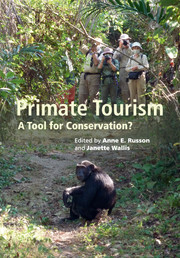Book contents
- Frontmatter
- Contents
- List of contributors
- Part I Introduction
- Part II Asian primates
- Part III African primates
- Part IV Neotropical primates
- 12 The impact of tourist group size and frequency on Neotropical primate behavior in Tambopata, Peru
- 13 Interactions between tourists and white-faced monkeys (Cebus capucinus) at Manuel Antonio National Park, Quepos, Costa Rica
- 14 Effects of tourism on Ecuadorian primates
- Part V Broader issues
- Part VI Conclusion
- Index
- References
13 - Interactions between tourists and white-faced monkeys (Cebus capucinus) at Manuel Antonio National Park, Quepos, Costa Rica
from Part IV - Neotropical primates
Published online by Cambridge University Press: 05 September 2014
- Frontmatter
- Contents
- List of contributors
- Part I Introduction
- Part II Asian primates
- Part III African primates
- Part IV Neotropical primates
- 12 The impact of tourist group size and frequency on Neotropical primate behavior in Tambopata, Peru
- 13 Interactions between tourists and white-faced monkeys (Cebus capucinus) at Manuel Antonio National Park, Quepos, Costa Rica
- 14 Effects of tourism on Ecuadorian primates
- Part V Broader issues
- Part VI Conclusion
- Index
- References
Summary
Introduction
Tourism, particularly wildlife-based tourism, is one of the fastest growing industries in the world. Tourism currently accounts for 10.8% of the global gross domestic product and it is expected to grow by 4.6% annually over the next ten years (World Travel and Tourism Council, 2005). Twenty to forty percent of international tourists are interested in wildlife-based experiences and this high market share results in fierce competition among tour operators to provide more wildlife tourism opportunities (Reynolds & Braithwaite, 2001). Many countries and organizations are counting on this demand to grow local economies sustainably while protecting the environment. However, more and more research is finding that wildlife-based tourism is not a panacea for habitat loss. In promoting nature as a tourist attraction, natural surroundings can be negatively affected (Knight & Cole, 1995; Ziffer, 1989). Introducing people into an environment will have some effect, be it production of litter, construction of trails and buildings, changes in the local culture, or changes in the behavior of the wildlife. Effects of tourism on wildlife can vary from feeding and activity budget changes (Ikiara & Okech, 2002) to reproductive changes (Jacobson & Lopez, 1994), ranging changes (Fairbanks & Tullous, 2002), and deaths of individual animals (Mathieson & Wall, 1982; Roe et al., 1997). Indeed, one review found that 81% of studies investigating the effects of wildlife tourism on animals classified tourism impacts as harmful (Knight & Cole, 1995).
Successful sustainable tourism must strike a balance between preserving the environment, enriching local communities, and providing memorable experiences to tourists. These disparate goals may not always be compatible. Research results demonstrate that tourist satisfaction increases as tourists are allowed more control over their encounters with wildlife (Reynolds & Braithwaite, 2001; Sparks, 1994) and closer contact with wildlife (Farber & Hall, 2007; Fredrickson & Anderson, 1999; Valentine et al., 2004). Tourists also prefer experiences during biologically active times, such as birth or breeding seasons (Reynolds & Braithwaite, 2001). These close encounters can result in danger for the tourists, such as being bitten by the animals (Albert & Bowyer, 1991; Brennan et al., 1985; Fairbanks & Tullous, 2002), and danger for the animals in the form of increased chances of disease transmission from human to animal (Kaur & Singh, 2008; Köndgen et al., 2008; Wallis & Lee, 1999).
- Type
- Chapter
- Information
- Primate TourismA Tool for Conservation?, pp. 230 - 244Publisher: Cambridge University PressPrint publication year: 2014
References
- 1
- Cited by



